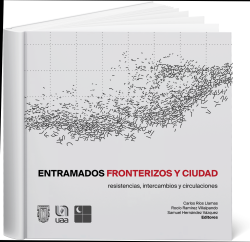Border networks and city: Resistance, exchanges, and circulation
Keywords:
Borders, Geographical borders, Symbolic borders, Economic inequalities, Hidden forms of violence, Obstruction of free flow, Disputes, Negotiations, Intersections, Social fabric, Territorial essence of cultures, Cultural borders, Forces of resistance, Social exchange, Human circulation, Cultural imperialisms, United States-Mexico Relationship, Sovereignty, Social Hybridization, Interactions between Societies, Cultural Landscapes, City, Discourse of Globalization, Freedom, Neoliberal Models, Borderization, The Other Remove The Other, North-South Relations, SouthBorder territories, Border territories, Cultural resistance, Economic hegemony, Cultural hegemony, Coloniality of power, InterculturalityMulticulturalism, Multiculturalism, Transculture, Housing and gender iminate, Railroad housing, Aguascalientes, Deinstitutionalization, Religious beliefs, Border landscape, Border wall, Digital press, Artisanal exchanges, Networks, NetworksTransrural routes, Calexico, Mexicali, Gender boundaries, Advertising, Ciudad Juárez, Agricultural land, Urban expansion, Urban-rural transformationSynopsis
The beginning of the 21st century is characterized by the multiplication of borders between nations and the violent polarization of cynical leaderships under the pretext of security and sovereignty. In contrast to the discourse of globalization and the promise of a homogeneous world, the current scenario is marked by narratives of new frontiers, the product of increasingly violent neoliberal models. Therefore, rather than talking about borders, it is more appropriate to analyze the processes of "borderization," that is, the confinement of spaces and the expulsion of the other, whether migrant, racialized, or poor. In this logic, the border encapsulates the places "where the freedom to come and go is deactivated and where the lives of the multitude of people considered useless are immobilized, if not rotated."
One of the main objectives of this book is to challenge the notion of cultural imperialism, which manifests itself most strongly in North-South relations and border territories between cities and countries. The free flow of resources between cultures is interrupted by economic asymmetries between systems and hidden forms of violence that are established at geographical borders and symbolic demarcations between individuals and societies. However, dynamics of cultural resistance are also activated, allowing for a critical evaluation of the consequences, both positive and negative, of cultural imperialisms—such as that of the United States on the Mexican border—as well as the contradictions and ambivalences of the economic factors that govern intercultural relations.
The notion of exchange from a border perspective can be approached from multiple angles. In this book, it is presented based on the constant links and structures of interaction within which social beings are inserted between borders. Resources and activities converge in societies that exchange on a daily basis. These connections enable interaction, highlighting that there are different perspectives for approaching the events and relationships that generate this process. Undoubtedly, one of the aspects to highlight is exchange from a political-economic perspective—that of transactions—relationships established based on market needs and the political strategies of nations.
The chapter "Glass ceilings, opaque walls, and broken pipes: gender-based housing boundaries" offers an analysis based on architectural design and gender boundaries that become blurred when everything revolves around the international wall in cities such as Mexicali-Calexico. From a historical perspective, Rocío Ramírez Villalpando's chapter reflects on the "Journey to railroad housing in Aguascalientes and Mexicali." Samuel Hernández Vázquez's text, "Disenstitutionalization of religious beliefs and practices in Mexicali," puts into theoretical perspective the spirit, syncretism, and orthodox and heterodox religious practices in Mexicali. The chapter "Imaginaries of a border landscape. The wall between Mexico and the United States from the digital press" focuses on the tangible division of the binational wall, which is incorporated into the landscape not only as an imposed element, but also in the social imaginary as an element that shapes the territory. Natalia Zepeda Cazarez's text, entitled "Circulation and Artisanal Exchanges: Trans-Rural Networks and Routes in San Cristóbal Zapotitlán, Jocotepec, Jalisco," shows artisan families building links and creating networks that allow them to take their artisanal products to other national and international spaces. In his chapter entitled "Beyond the boundaries between Calexico and Mexicali: The border and its meanings," Carlos Gándara Woongg addresses different conceptions of the border—geographical, political, virtual, and symbolic—based on the case of Calexico and Mexicali to show how the border condition has acquired and transformed its territory based on the cultural manifestations that impact it. The study on "Gender borders and the vulnerability of women in advertising in Ciudad Juárez" emphasizes the establishment of stereotypes about the image of women and girls in border cities. In Juan Pablo Romero Carvajal's chapter, entitled "The impact of agricultural land on urban expansion in Mexicali. Urban-rural transformations," the main changes introduced by the 1992 Agrarian Law Reform in the border territory are discussed.
Chapters
-
Introduction
-
Glass ceilings, opaque walls, and broken pipes: gender-based housing barriers
-
Journey to the railroad housing in Aguascalientes and Mexicali during the first half of the 20th century
-
Imaginaries of a border landscapeThe wall between Mexico and the United States from the digital press
-
Deinstitutionalization of religious beliefs and practices in Mexicali
-
Circulation and artisanal exchanges: transrural networks and routes in San Cristóbal Zapotitlán, Jalisco
-
The border and its meaningsBeyond the borders between Calexico and Mexicali
-
Gender boundaries and women's vulnerability in Ciudad Juárez advertising
-
The impact of agricultural land on urban expansion in MexicaliUrban-rural transformations

Downloads
Published
Series
Categories
License

This work is licensed under a Creative Commons Attribution-ShareAlike 4.0 International License.






